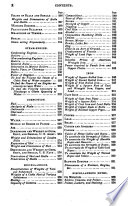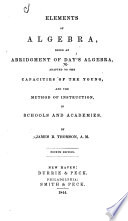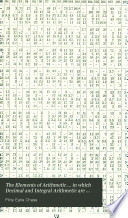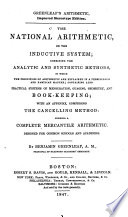 | Charles Haynes Haswell - Engineering - 1844 - 298 pages
...in 12 hours ? 12X (134-2) =78 4«t. When the Common Difference and the Extremes are gieen, to find the Number of Terms. RULE.— Divide the difference of the extremes by the common difference, and add one to the quotient. EXAMPLE. — A man travelled 3 miles the first day, 5 the second, 7 the third,... | |
 | James Bates Thomson - Algebra - 1844 - 266 pages
...and the number of terms is ten. What is the common difference 1 Prob. 21. The extremes o/ a series are 3 and 39, and the common difference 2. What is the number of terms 1 / 5 Prob. 22. Find 5 means between 6 and 48. Prob. 23. Find 6 means between 8 and 36. r . r. 336.... | |
 | James Bates Thomson - Algebra - 1844 - 272 pages
...and the number of terms is ten. What is the common difference 1 Prob. 21. The extremes of a series are 3 and 39, and the common difference 2. What is the number of terms1 Prob. 22. Find 5 means between 6 and 48. Prob. 23. Find 6 means between 8 and 36. 336. Problems... | |
 | Pliny Earle Chase - Arithmetic - 1844 - 246 pages
...5, gives 7, which must be equal to the number of terms less 1. Therefore the number of terms is 8. RULE. Divide the difference of the extremes by the common difference, and add 1 to the quotient. 13. What is the sum of the series 2, 4, 6, 8, &c., to 1000? 14. What is the... | |
 | Pliny Earle Chase - 1844 - 258 pages
...5, gives 7, which must be equal to the number of terms less 1. Therefore the number of terms is 8. RULE. Divide the difference of the extremes by the common difference, and add 1 to the quotient. 13. What is the sum of the series 2, 4, 6,8, &c., to 1000? 14. What is the sum... | |
 | Almon Ticknor - Arithmetic - 1846 - 274 pages
...will be doubled. Given the extremes and the common difference, to find the number of terms. RULE in. Divide the difference of the extremes by the common difference, and the quotient, increased by 1, will be the number of terms required. 5. The extremes are 3 and 39, and the common... | |
 | William Vogdes - Arithmetic - 1847 - 324 pages
...Washington ? § 166. CASE 3. Given the first term, the last term, and the common difference, to find the number of terms. RULE. Divide the difference of...extremes by the common difference, and the quotient increased by 1 is the number of terms required. EXAMPLES. 1. The extremes are 2 and 53, and the common... | |
 | Benjamin Greenleaf - Arithmetic - 1847 - 336 pages
...miles, 2 rods. PROBLEM III. Given the extremes and the common difference, to find the number of terms. 1 RULE. Divide the difference of the extremes by the common difference, and the quotient increased by one, will be the number of terms required 9. Tf the extremes are 3 and 45, and the common... | |
 | Arithmetic - 1847 - 292 pages
...the first term, the last term, and the common difference, tojind the number of terms. RULE. — 0) Divide the difference of the extremes by the common difference, and the quotient increased by one is the number of terms required. Question. — 1. The first and last terms, and common... | |
 | James Bates Thomson - Arithmetic - 1847 - 434 pages
...common difference ? To find the number of terms, when the extremes and common difference are given. Divide the difference of the extremes ~by the common difference, and the quotient increased by 1 will be the number of terms. OBS. Tlie truth of this principle is manifest from the... | |
| |